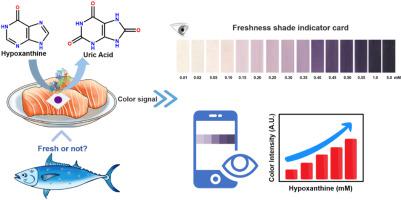Our official English website, www.x-mol.net, welcomes your feedback! (Note: you will need to create a separate account there.)
Green manufacturing of a hypoxanthine enzyme sensor for fish freshness based on modified nitrocellulose surface with chito-oligosaccharide
Talanta ( IF 6.1 ) Pub Date : 2024-03-30 , DOI: 10.1016/j.talanta.2024.126007 Yilin Wang , Xiaoyun Zhang , Maole Wei , Huigang Kang , Zhenqiang Zhang , Xiudan Wang , Cuiping Ma
Talanta ( IF 6.1 ) Pub Date : 2024-03-30 , DOI: 10.1016/j.talanta.2024.126007 Yilin Wang , Xiaoyun Zhang , Maole Wei , Huigang Kang , Zhenqiang Zhang , Xiudan Wang , Cuiping Ma

|
Hypoxanthine (Hx), produced by adenosine triphosphate (ATP) metabolism, is a valuable indicator that determines the quality and degradation status of meat products and is also an important biochemical marker to certain diseases such as gout. The rapid emergence of paper-based enzyme biosensors has already revolutionized its on-site determination. But it is still limited by the complex patterning and fabrication, unstable enzyme and uneven coloration. This work aims to develop an eco-friendly method to construct engineered paper microfluidic, which seeks to produce reaction and non-reaction zones without any patterning procedure. Chito-oligosaccharide (COS), derived from shrimp shells, was used to modify nitrocellulose membranes and immobilize xanthine oxidase (XOD) and chromogenic agent of nitro blue tetrazolium chloride (NBT). After modification, micro fluids could converge into the modification area and Hx could be detected by XOD-catalyzed conversion. Due to the positively charged cationic basic properties of COS, the enzyme storage stability and the color homogeneity could be greatly strengthened through the electrostatic attraction between COS and XOD and formazan product. The detection limit (LOD) is 2.30 μM; the linear range is 0.05–0.35 mM; the complete test time can be as short as 5 min. The COS-based biosensor shows high specificity and can be used directly for Hx in complex samples such as fish and shrimp samples, and different broths. This biosensor is eco-friendly, nontechnical, economical and therefore a compelling platform for on-site or home-based detection of food freshness.
中文翻译:

基于壳寡糖改性硝基纤维素表面的鱼鲜度次黄嘌呤酶传感器的绿色制造
次黄嘌呤(Hx)由三磷酸腺苷(ATP)代谢产生,是决定肉制品质量和降解状况的重要指标,也是痛风等某些疾病的重要生化标志物。纸基酶生物传感器的迅速出现已经彻底改变了其现场测定。但它仍然受到复杂的图案和制造、不稳定的酶和不均匀的着色的限制。这项工作旨在开发一种环保的方法来构建工程纸微流控,该方法旨在无需任何图案化程序即可产生反应区和非反应区。利用虾壳提取的壳寡糖(COS)对硝基纤维素膜进行修饰,并固定黄嘌呤氧化酶(XOD)和硝基蓝四唑氯化物(NBT)显色剂。改性后,微流体可以聚集到改性区域,并且可以通过XOD催化转化检测到Hx。由于COS带正电的阳离子基本特性,通过COS与XOD和甲臜产物之间的静电吸引,可以大大增强酶的储存稳定性和颜色均匀性。检测限(LOD)为2.30 μM;线性范围为 0.05–0.35 mM;完整的测试时间可短至5分钟。基于COS的生物传感器表现出很高的特异性,可直接用于复杂样品(如鱼虾样品和不同肉汤)中的Hx。这种生物传感器环保、非技术性、经济,因此是现场或家庭食品新鲜度检测的一个引人注目的平台。
更新日期:2024-03-30
中文翻译:

基于壳寡糖改性硝基纤维素表面的鱼鲜度次黄嘌呤酶传感器的绿色制造
次黄嘌呤(Hx)由三磷酸腺苷(ATP)代谢产生,是决定肉制品质量和降解状况的重要指标,也是痛风等某些疾病的重要生化标志物。纸基酶生物传感器的迅速出现已经彻底改变了其现场测定。但它仍然受到复杂的图案和制造、不稳定的酶和不均匀的着色的限制。这项工作旨在开发一种环保的方法来构建工程纸微流控,该方法旨在无需任何图案化程序即可产生反应区和非反应区。利用虾壳提取的壳寡糖(COS)对硝基纤维素膜进行修饰,并固定黄嘌呤氧化酶(XOD)和硝基蓝四唑氯化物(NBT)显色剂。改性后,微流体可以聚集到改性区域,并且可以通过XOD催化转化检测到Hx。由于COS带正电的阳离子基本特性,通过COS与XOD和甲臜产物之间的静电吸引,可以大大增强酶的储存稳定性和颜色均匀性。检测限(LOD)为2.30 μM;线性范围为 0.05–0.35 mM;完整的测试时间可短至5分钟。基于COS的生物传感器表现出很高的特异性,可直接用于复杂样品(如鱼虾样品和不同肉汤)中的Hx。这种生物传感器环保、非技术性、经济,因此是现场或家庭食品新鲜度检测的一个引人注目的平台。



























 京公网安备 11010802027423号
京公网安备 11010802027423号